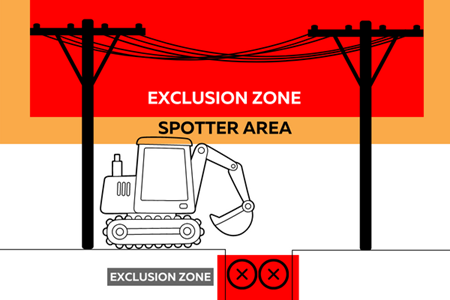What are exclusion zones?
Exclusion zones are there to keep you safe. They are there to show the safe working distances surrounding electrical assets. The size of an exclusion zone (usually measured in metres) is determined by the voltage of the electrical equipment on site.
It's important to remember:
- Exclusion zones are designed to protect workers and the public. Coming close to electric wires could cause the electricity to arc and jump.
- No person, plant, or material can enter the exclusion zone of an electrical powerline or electrical asset.
- Exclusion zones apply to both overhead and underground powerlines.
- If your works enter an electrical exclusion zone, you may be prosecuted and be liable for any damage to the electricity network.
- Electricity distributors have an obligation to inform a WorkSafe or SafeWork agency of any non-compliance concerns.
It's not just unsafe - it's illegal!
Legislation, standards, and codes of practice are there to keep workers and the community safe. They must be followed when working near electricity. Non-compliance can also result in prosecution, fines, the loss of skilled staff and even injuries or death.
If you are responsible for a work site or team, it’s important to remember Work Health and Safety (WHS) requires the management of risks that impact the health and safety of everyone in your workplace. For businesses, this includes anyone working for you as well as your customers, visitors, and suppliers.
The dangers are real
Here are some real-life examples of electrical incidents in the workplace:
- Life changing injuriesA young scaffolder had his arms amputated and suffered horrific burns in a workplace accident when a high-powered electric shock ripped through his body. It's believed the 28-year-old father was holding a steel pole when it touched low-hanging overhead powerlines.
- Fines and prosecutionA family-run billboard company in Queensland was fined $250,000 after one of its workers received an electric shock from an overhead powerline. The worker had been changing the skin on an advertising sign within a three-metre exclusion zone of powerlines.
what are the dos and don'ts when it comes to exclusion zones?
Do
-
Use a safety observer to make sure works remain outside of exclusion zones.
- Make powerlines and poles visible. Use tiger tails or other visual indicators for overhead powerlines (contact your electricity distributor), or mark the position of underground cables with spray paint (from information in BYDA plans).
- If you’re working near vegetation, plan your work so tree branches or debris don’t come into contact with powerlines.
- Where possible, use insulated or non-conductive tools and equipment.
- Follow the safety advice you obtain from the local electrical distributor.
Don't
- Don’t start work before confirming the location and voltage of electrical powerlines and assets.
- Don’t lift loads directly underneath or over the top of powerlines.
- Don’t start work without checking the height of loads.
- Don’t start work without determining the extension, reach, and height of equipment near powerlines.

Working near powerlines



